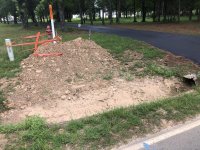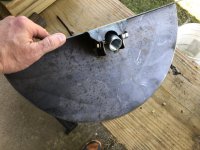Faulkner
Member
Some may or may not be familiar with the American Rescue Plan funds of which over 1 trillion dollars were distributed to state, county, and city governments across America. Without getting too deep into the ARP, the intent of those tax dollars being distributed is for local governments to spend them on COVID mitigation, premium pay for those essential workers impacted by COVID, or for infrastructure projects including sewer, water, and broadband to underserved areas. The funds cannot be spent on roads or jails.
Our county received well over $10 million dollars of ARP funds, and the state of Arkansas received about half a billion dollars just for broadband expansion for underserved areas, and for a rural state like Arkansas that covers a lot of ground.
The direct impact to me and my family is that broadband is being upgraded in the remote area I live in. The specifications for broadband funded by ARP is that it has to be fiber optic with minimum speeds of 100 mps down and 25 mps up. My current DSL speed at home is 20 mps down and 5-6 mps up, so it will be a pretty significant upgrade for me.
The downside is that the contractors have been working on it since late February and as we near June it's not near being completed. They started by trenching the easement at the road in front of my property and have allow it to stay open for a few weeks before they came back and laid the PVC conduit, but they didn't come back and cover it up until early May. They still have not run the fiber and the junction points are still open pits. Since this was in the rainy season, all that loose dirt has washed down into the ditches in front of our place filling them and the driveway culverts with sediment. For the past 25 years I've mowed the ditch in front of my place, now it's just a quagmire.
This is a picture of one of the open junction pits next to my driveway, but the trench goes on another 300 yards on the other side of my driveway to the next culvert. We've never had a water runoff problem before, but now with all the culverts half clogged we have water backing up and running over the roadway every time it rains.

I've talked to the contractor and the county road department foreman and they assure me it'll get cleaned up when they're finished . . . but that may not be until the fall. No one is willing to clean out the culverts until the project is done.
So, after our most recent rain I decided I'd try to deal with my culvert myself. I have a 18 inch culvert that is 24 feet long. I got on line and found some expensive culvert cleaners, but I decided I could engineer one myself. I went to one of my buddies who is a welder & trailer manufacturer and told him what I had in mind. We went out back and found some scrap sheet metal and formed us a 16 inch culvert scrapper that will easily fit inside my 18 inch culvert. We made a swivel bracket with a 1/2 threaded conduit coupler on it so we could screw in a 12 foot piece of threaded rigid conduit for a handle. With a 12 foot handle I should be able to scrap out the sediment half way from either side.
I gave it a test run with a 6 foot handle and it seemed to work well enough, but I can tell it will certainly test those back and shoulder muscles. I'm going to go back to see my welding buddy on Monday and see if we can develop an attachment for my tractor and use a little diesel horse power rather than man power.

Our county received well over $10 million dollars of ARP funds, and the state of Arkansas received about half a billion dollars just for broadband expansion for underserved areas, and for a rural state like Arkansas that covers a lot of ground.
The direct impact to me and my family is that broadband is being upgraded in the remote area I live in. The specifications for broadband funded by ARP is that it has to be fiber optic with minimum speeds of 100 mps down and 25 mps up. My current DSL speed at home is 20 mps down and 5-6 mps up, so it will be a pretty significant upgrade for me.
The downside is that the contractors have been working on it since late February and as we near June it's not near being completed. They started by trenching the easement at the road in front of my property and have allow it to stay open for a few weeks before they came back and laid the PVC conduit, but they didn't come back and cover it up until early May. They still have not run the fiber and the junction points are still open pits. Since this was in the rainy season, all that loose dirt has washed down into the ditches in front of our place filling them and the driveway culverts with sediment. For the past 25 years I've mowed the ditch in front of my place, now it's just a quagmire.
This is a picture of one of the open junction pits next to my driveway, but the trench goes on another 300 yards on the other side of my driveway to the next culvert. We've never had a water runoff problem before, but now with all the culverts half clogged we have water backing up and running over the roadway every time it rains.
I've talked to the contractor and the county road department foreman and they assure me it'll get cleaned up when they're finished . . . but that may not be until the fall. No one is willing to clean out the culverts until the project is done.
So, after our most recent rain I decided I'd try to deal with my culvert myself. I have a 18 inch culvert that is 24 feet long. I got on line and found some expensive culvert cleaners, but I decided I could engineer one myself. I went to one of my buddies who is a welder & trailer manufacturer and told him what I had in mind. We went out back and found some scrap sheet metal and formed us a 16 inch culvert scrapper that will easily fit inside my 18 inch culvert. We made a swivel bracket with a 1/2 threaded conduit coupler on it so we could screw in a 12 foot piece of threaded rigid conduit for a handle. With a 12 foot handle I should be able to scrap out the sediment half way from either side.
I gave it a test run with a 6 foot handle and it seemed to work well enough, but I can tell it will certainly test those back and shoulder muscles. I'm going to go back to see my welding buddy on Monday and see if we can develop an attachment for my tractor and use a little diesel horse power rather than man power.


